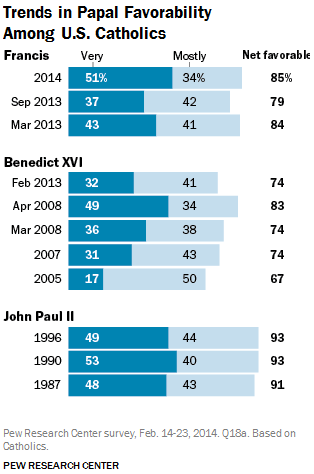
Ja, har er faktisk ikke mer populær blant amerikanske katolikker enn pave Johannes Paul II og pave Bededikt XVI, skriver Sandro Magister – for alle tre var svært populære. Magister skriver bl.a.:
… John Paul II and Benedict XVI also had very high approval ratings, or even higher. But only among the faithful. On the outside there was tough opposition.
Francis has rounded the corner of his first year driven by an immense popularity. But there is nothing new in this. In 2008 Benedict XVI had also reached identical levels of consensus. And John Paul II had been even more popular, and for many years afterward.
The novelty is something else. With Francis, for the first time in ages a pope is being lauded not only by his own, but almost more so by those on the outside, by secular public opinion, by the secular media, by governments and international organizations.
Even the report of a UN commission that at the beginning of February ferociously attacked the Church spared him, bowing to that “who am I to judge?” now universally taken up as the emblematic motto of the “openness” of this pontificate.
Not with his two predecessors. At the apogee of their popularity they had the Christian people on their side. But all the others were against them.
In fact, the more the “age» opposed the pope, the larger the pope himself loomed. The magazine “Time” dedicated the man of the year cover to John Paul II in 1994, the year of the pitched battle that he waged, almost alone against the rest of the world and the American administration foremost, before, during, and after the UN conference in Cairo on birth control and therefore, according to the pope, for «the systematic death of the unborn.»
Karol Wojtyla had made 1994 the year of the family because he saw it threatened and attacked, when instead at the approach of the new millennium, in the vision of the pope, it should have shone as at the beginning of creation, male and female, increase and multiply, and “let man not separate what God has united.”
In 1994 John Paul II also wrote a letter to the bishops to reiterate the ‘no’ on communion for the divorced and remarried. And he spoke another categorical ‘no’ on women priests. …..
… The more John Paul II was dismissed by secular opinion as obscurantist and backward, the higher his popularity among Catholics was. During that decade it was stable at 93 percent in favor, about ten points higher than Pope Francis today and Benedict XVI in 2008.
The arc of Pope Joseph Ratzinger is also exemplary, Just after he was elected, in 2005, his popularity among Catholics was low, at 67 percent, with only 17 percent saying they were very favorable. But he gradually won greater consensus, in spite of the rigor with which he criticized the challenges of modernity. …..
…. The lesson that can be gathered from this is that a pope’s success among the faithful is not automatically connected to his pliability on crucial questions. Two intransigent popes like John Paul II and Benedict XVI registered very high popularity levels.
The «openness» of a pope to modernity can instead explain the consensus he gets from the outside, from secular opinion. This seems to be the novelty of Francis.
A novelty that deep down he mistrusts. He said in his recent interview with «Corriere della Sera»: «I don’t like a certain mythology of Pope Francis. Sigmund Freud said, if I am not mistaken, that in every idealization there is an aggression.»
